Breathers: A Zombie’s Lament / S.G. Browne
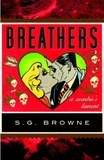 Broadway Books / March 2009
Broadway Books / March 2009
Reviewed by: Martel Sardina
If you’ve never woken up to discover that you’ve become an animated, rotting corpse, then you need to read S.G. Browne’s Breathers: A Zombie’s Lament to prepare yourself for the world that awaits should you ever become the victim of spontaneous resurrection.
Andy Warner has already suffered that fate. Andy was a happily married father until a car accident turned his world upside down. Andy lost his wife, Rachel, in the accident. Their daughter, Annie, has been taken in by relatives and is unaware of her father’s resurrection. Andy is trying to adjust to his new life as one of the undead. However, the world he came back to does not want him.
In Andy’s world, zombies are second-class citizens, if they can be considered citizens at all. They have no rights. They can’t get jobs. Attempts to interact with the living – or “Breathers” – usually end with a trip to the SPCA where they are held in cages like stray animals until being reclaimed by their guardians. Unclaimed zombies often end up in zoos or are sold to medical research facilities, which is exactly where Andy would be if his father had a say in the matter. Fortunately, his mother hasn’t completely given up on her son.
Andy’s parents claimed him from the SPCA and brought him home. They allow him to live in their wine cellar. (Well, you can’t have a zombie stinking up the whole house, now can you?) They pay for him to see a therapist and have encouraged him to get involved with Undead Anonymous, an organization that will no doubt help him in the struggle to make sense of his return.
It is what happens after Andy realizes that being undead doesn’t mean his “life” can’t have a purpose that the fun kicks into high gear.
Last year, Daniel Waters showed us what the world would be like if zombies were allowed to reintegrate into society in Generation Dead. Waters gave readers a plausible explanation for why the dead come back and why some are higher functioning than others. Browne does not offer an explanation for the zombie resurgence. Readers are asked to accept that the zombies are here and that they function cognitively as the same level that they did prior to their death. While this reviewer felt Waters explanation enhanced the story, Browne’s lack of explanation does not impede a reader’s ability to “believe.”
Both Generation Dead and Breathers share some common ground in terms of how zombies are viewed by society at large. While Waters takes a more serious approach to the underlying theme of racial discrimination, readers will no doubt enjoy Browne’s satirical approach. This reviewer makes her comparisons based on content, but must mention that the markets for the two novels are wholly different. Generation Dead is a YA novel; Breathers is not. It contains violence and gore and with lines like, “Is it really necrophilia if we’re both dead?” proves that it is intended for mature audience. That said, adults who read Generation Dead but wished it had incorporated more of what readers expect to see in zombie fiction will be pleasantly surprised with Breathers as a result.
Purchase Breathers: A Zombie’s Lament by S.G. Browne.
Flesh Is Fleeting...Art Is Forever / Gary A. Braunbeck; Thin Them Out / Kim Paffenroth, R.J. Sevin and Julia Sevin
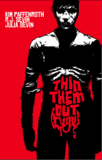
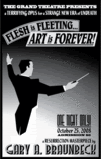 Creeping Hemlock Press / October 2008
Creeping Hemlock Press / October 2008
Reviewed by: Blu Gilliand
In preparation for the 2008 Zombie Fest Convention that took place late October in the Monroeville Mall near Pittsburgh, Pennsylvania – a site revered by horror movie buffs as the setting of George Romero’s Dawn of the Dead – Creeping Hemlock Press decided to quickly pull together a couple of chapbooks to sell. In a matter of weeks, they managed to put together two projects that will further cement their status as one of the most reliable small presses operating today.
Taken together, the two chapbooks – Gary Braunbeck’s Flesh Is Fleeting…Art Is Forever, and Thin Them Out, written by Kim Paffenroth with R.J. and Julia Sevin (the husband-and-wife team behind Creeping Hemlock) – present wildly different visions of a world overrun with the living dead.
Braunbeck travels a route unfamiliar to most zombie fiction, one in which things have returned to at least a semblance of normality. The plague has been contained, and measures are in place to keep reanimation in check. As for the zombies that haven’t been destroyed, they are being put to use. They are our ushers, our bricklayers, our manual laborers. And, in this case, our entertainment.
For Flesh Is Fleeting, Braunbeck adopts the voice of Wendell Shakelton-Baily III, a supremely fussy critic of The Arts. The entire story is presented as Bailey’s review of Symphony For A World Unmade, the latest symphonic masterpiece of composer/conductor Michael Russell. The performance is, Shakelton-Bailey assures us, much more than a mere concert; it is a multi-layered commentary on the post-Resurrection world. Its most powerful statement is the fact that the musicians performing it are, themselves, the undead.
In Shakelton-Bailey, Braunbeck perfectly captures and satirizes the snooty, self-important voice of the Critic, those who would place themselves in position to tell everyone else what is good and what is not. (What? Why are you looking at me that way?) And, while doing so, he writes a cracking good zombie yarn, one that ends in a way both expected and surprising.
Thin Them Out takes us on a more familiar journey through the zombie genre. Society is in shambles, and the living have banded together in small guerrilla-type groups, carving out lives for themselves in abandoned high-rises and warehouses, always moving, always scavenging – and doing their best to thin out the shambling hordes of the dead.
Thin follows one such collective. Barricaded in an old warehouse in Louisiana, they’re living as normally as they can under the circumstances, relying on a small group of men to go out and collect food and other vital supplies. But that group is getting progressively smaller – more often than not, not everyone makes it back from the scavenging trips alive, and some of the people are beginning to believe that the zombies aren’t the ones doing the killing.
Paranoia, suspicion, back-alley plans – all the elements that really make zombie fiction hum are found here. It’s a fast-paced tale with twists and turns laid throughout its compact 30-plus pages. Kudos especially to the three authors for blending into one distinct voice – collaborations are difficult to pull off, but they do a nice job here.
Quick turn-around time or not, these books look just as good as they read. Yes, a couple of typos do slip in, but I’ve seen much worse in mass market editions that were pored over for months. Both of these chapbooks are fine additions to the Creeping Hemlock line, and to the undead genre as a whole. Highly recommended.
Purchase Flesh Is Fleeting...Art Is Forever by Gary A. Braunbeck.
Purchase Thin Them Out by Kim Paffenroth, R.J. Sevin, and Julia Sevin.
Angel Land / Victor J. Banis
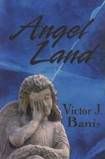 Regal Crest Enterprises, LLC / September 2008
Regal Crest Enterprises, LLC / September 2008
Reviewed by: Rick R. Reed
An avowed fundamentalist preacher gives the invocation at a presidential inauguration. A vote makes it against the law for people to marry those whom they love. Couples with good homes find it suddenly illegal to adopt or nurture foster children. These are not the elements of a fictional story, but headlines ripped from the news today.
It’s these headlines that make Victor J. Banis’s visionary novel, Angel Land, so ready for prime time. Banis peers into a literary crystal ball and sees a brave new post-apocalyptic world made all the more terrifying by the fact that these visions are not the ephemeral stuff of nightmares, but dire predictions based on present day politics, religion, and life.
Welcome to the new United States, late in the 21st century: America has been divided into the Fundamentalist Christian Territories. Catholics, Baptists, and Jews are now registered as heretics. Gays have been rounded up and live in walled ghettoes known as the “Zones of Perversion.” A deadly virus, a mutation of the AIDS scourge, called Sept, has decimated the population, making those remaining fearful and afraid to challenge the new regime, who keep tight control over the only medication that will keep victims of the plague healthy and alive. And because Sept is airborne, almost everyone is infected.
Banis has imagined a horrifying world, made all the more horrifying by the fact that many of today’s trends could lead to just such a world. Twisted Christian beliefs and the potent odor of fear are two factors that have already proven their power to deny equal rights to part of the population. Banis just plays these fears out to a logical, terrifying, and brutal conclusion.
But Banis’s dark new world is not without hope. Enter Harvey Milk Walton, the kind of messiah with whom we can all identify. He’s unsure of himself, still damp behind the ears, and not immune to the pleasures of the flesh—just like most of us. But unlike us, Harvey Milk Walton carries within him the seed of a mission: to be a savior in this shadowy, grim universe. He has an uncanny knack for being in the right place at the right time, for figuring out how to thwart evil, and for uncovering and exposing the mysteries behind it. Banis’s cock-eyed savior is a lovable, flawed character, which makes him all the easier for a reader to take him to heart and to care about him and the people he’s destined to save.
Banis is something of an iconic figure himself: his early novels, published in the 1960s and 70s, were some of the first to deal with gay life and sexuality in a popular format. His adherence to writing about people who were disenfranchised and looked down upon by so-called normal society forced him into the role of crusader for free speech and got him embroiled in his own legal battles. I think this role as an underdog and voice for people who could not then speak out, gave Banis the ability to make Harvey Milk Walton such a sympathetic character, one who, despite his all-too-human flaws, is filled with common sense and compassion.
Angel Land can be read on many levels. It is at once a rip-roaring good-against-evil thriller, a cautionary tale of which complacent souls might do well to take heed, and a horror story about the possibilities of goodness masquerading as evil. However you read Angel Land, you are sure to come away satisfied. This novel is the voice of a master storyteller and even if you pay little heed to the socio-political ideas between the lines, you are sure to come away knowing you have had a deeply satisfying reading experience.
Purchase Angel Land by Victor J. Banis.
Ebook edition also available here.
Castaways / Brian Keene
 Leisure Books / February 2009
Leisure Books / February 2009
Reviewed by: Vince A. Liaguno
About halfway through Brian Keene’s Castaways, one is reminded of that infamous tagline from The Texas Chain Saw Massacre: “Who will survive and what will be left of them?” Indeed, after this white-knuckle fiction screamfest, there may be very little left of readers’ nerves. Relentlessly frightening and viscerally brutal, Castaways combines non-stop action with an old school horror abandon that gives readers scarce time to come up for air.
On a lush tropical island, contestants of a Survivor-like reality show competition backstab and connive as each vie for the show’s million dollar grand prize. At the novel’s outset, thirteen of the twenty original contestants are several weeks into the competition, having already “exiled” several of their number as part of the show’s elimination process. They’re joined on the allegedly deserted island by a rotating crew of cameramen, medics, field producers, and a pompous, preening host there to coordinate, manipulate, and film their every move.
When a cyclone heads for the island, only a skeleton crew of three remains with the unlucky thirteen, the rest taking refuge on an offshore freighter that’s home to the exiled contestants, production crew and equipment. Just as the storm is about to hit, all hell breaks loose as the year-round residents of the island – a legendary lost tribe of savage half-human creatures – decide that they’re not up for company. Suffice to say that this is not Gilligan’s Island, and these are not your sitcom-variety headhunters.
What follows is, quite frankly, some of the best stuff to flow from the tip of Keene’s blood-soaked pen. As contestants and crew scramble, he expertly tracks and manages the large ensemble of characters, who endure a prolonged and vicious assault from both the storm and the cannibals. Blood coats the rain-soaked jungle as the contestants are eviscerated and torn limb-by-limb by the most ferocious creatures to stalk the written page in recent memory. And just when you think you can’t take another minute, Keene uses the literary equivalent of defibrillator paddles on a conscious person to amp up the tension even more.
That Keene is able to imbue almost every character with some kind of distinguishable traits that make the reader actually care when they’re slain is no small feat and one of the reasons why this book is destined to become a classic. Not surprising, Castaways is an homage to Keene's mentor, Richard Laymon, and comes across as the literary offspring of the late scribe’s The Woods Are Dark and Jack Ketchum’s Off Season…hopped up on amphetamines and juiced up with about a thousand volts of adrenaline.
In between the copious bloodshed, readers and reality TV fans alike will chuckle knowingly at Keene’s astute observations of reality show contestant demographics —with his own fictional cast resembling almost any season of Survivor. With a pair a African-American contestants, the requisite lone gay contestant, and the usual assortment of buff jocks, the voluptuous beauty, an obnoxious buffoon, the hothead, the all-American girl, the under-the-radar loner, and a smattering of middle-aged contestants, Keene’s fictional Castaways rings true right down to the challenges and makeshift shelters. This immediately recognizable pop culture setting makes the ensuing carnage all the more effective and chilling to the core.
At the heart of Castaways is Keene’s commentary on the barbaric nature of humanity — and how greed for money, power, and fame fuels our savagery toward one another. He personifies his exploration of the theme in both the cannibalistic creatures and their human counterparts, in the end proving that there’s little difference between those willing to exploit others and themselves for cold hard cash and the flesh-consuming creatures that haunt the jungle. He also explores how the façade of our culture’s so-called “reality” contributes to our collective apathy, using one of the more unlikely characters whose ulterior motive is one of the first genuine shocks of the novel. Even when Keene teeters dangerously close to overplaying the political card – here in a four-page theory on the dumbing down of America as a political conspiracy – he knows just when to pull back.
Other horror writers are going to hate Brian Keene this year. Launching Castaways so early in the new year, Keene (and publisher Leisure) have created an almost impossible act to follow. Unflinchingly vicious, heart-stopping, and immensely readable, Castaways is part throwback, part pop culture marvel, and all horror masterpiece. Easily Brian Keene’s best.
Purchase Castaways by Brian Keene.
Dead End Street / Rick R. Reed
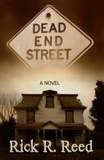 Amber Quill Press / October 2008
Amber Quill Press / October 2008
Reviewed by: Vince A. Liaguno
Rick Reed has got to be one of the busiest guys working in dark genre fiction right now. 2008, in particular, was a banner year for the dark scribe, with the publication of four novels — Deadly Vision, High Risk, Orientation, and now Dead End Street. Someone take this man on vacation!
With Dead End Street, Reed enters the burgeoning young adult market. Those familiar with Reed’s work – and those acquainted with his colorful blog postings – may at first scrunch their face at the idea and wonder how the oft titillating writer manages to pull this one off. But he does, effectively and suitably for the intended audience.
Dead End Street is a delightful haunted house story, framed by an effective use of the story-within-a-story narrative. Peter, Marlene, Erin, Roy, and David are imaginative eighth-graders from a small Ohio River town whose latest idea is the formation of a storytelling club, the Halloween Horror Club. The idea is simple: each member tells the most horrifying tale they can come up with and the scariest wins. The idea is initially knocked by the group, but Peter, who wears coke-bottle glasses and has been the imagination behind many of the group’s various clubs over the years, offers a unique twist: the stories will be told at the infamous Tuttle house, an abandoned residence on a wooded dead-end street that was once sight to an unsolved triple homicide.
Despite a few misgivings among the group, the teens’ curiosity in the macabre wins out and the club convenes the following week. Peter goes first, with his reimagining of the Tuttle mythos, one in which Paul Tuttle – the teenage son who went missing after the brutal slayings of his parents and young sister – is the victim of demonic possession after watching The Exorcist.
As each of the teens try to top each preceding story with their own tale of terror, the group begins to suspect that they’re not alone in the house. A creaking floorboard here, a mournful cry there, and the teens are suitably spooked as it’s revealed that a mysterious interloper watches and listens from the shadows of the house. Has Paul Tuttle returned to the scene of his alleged crimes to claim more victims? Do the ghosts of the Tuttle family haunt the house on the end of Acton Road? When one of their own stumbles into trouble trying to find out just what – or whom – haunts the Tuttle house, the group must summon its courage to save their friend and confront their own fears in the process.
The teens’ stories work as short, stand-alone tales within the novel and run the gamut of topics and themes —twin sisters lost in the snowy woods with a faceless terror, a werewolf dad for whom the full moon brings the ultimate tragic irony, a late-night driver on a road to nowhere, and a horror-obsessed teenage boy who enjoys scaring people (literally) to death. The stories work well here as campfire tales and help to bring insight into Reed’s teen cast of characters, even if some of the language choices border on precocious at times (“pince-nez glasses” or “The evening was placid.”).
Reed has proven himself time and time again at crafting solid stories in which the suspense ratchets up exponentially with each passing chapter. Dead End Street, even within the confines of its YA limitations, is no exception. The relatively short novel builds to an action-packed finale in which the teens run afoul of the house’s mysterious inhabitant, with Reed twisting and turning the story line just enough so that the reader is kept enjoyably off balance and surprised along the way.
Void of profanity and sexual content but brimming with just enough violence to appeal to teens without putting vigilant parents off, Dead End Street is a perfect YA horror experience for young readers. Adults familiar with Reed’s work and wanting to relive the nostalgia of their Goosebumps or Phyllis Whitney early reading experiences might also want to visit the Tuttle house.
Purchase Dead End Street by Rick R. Reed.
Miranda / John R. Little
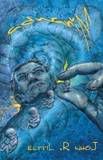 Bad Moon Books / September 2008
Bad Moon Books / September 2008
Reviewed by: Vince A. Liaguno
With age regression being the plot device du jour in film these days (just consider the Oscar buzz surrounding The Curious Case of Benjamin Button), timing is everything. And for John R. Little’s brilliant new novella, Miranda, the timing couldn’t be better.
Michael Johnson awakens to a shock one day — the electric jolt of defibrillator paddles bringing him back to life at age 65. He quickly learns that he’s living his life in reverse, swimming against the tide of time. He gets younger, not older. He meets his beloved dog at the time of its death, watches it revive and grow younger and healthier. He begins his career at retirement and works backwards through the years. But there’s a catch: everything and everyone else is moving forward. It’s a lonely existence, heartbreaking as he becomes a stranger to those he starts out knowing intimately.
That all changes when he meets the titular character, a woman, who, like him, is a backtracker. Like trains passing in opposite directions on parallel tracks, Michael and Miranda watch as everything they do goes in reverse. Still, they move in tandem together against the backwards tide and life is happy for awhile. But while Michael finds contentment in his relationship with Miranda, living a life already lived, she is troubled by the predetermined nature of their existence. In her quest to exercise free will and break the binding chains of a fated existence, heartbreak ensues. Little takes readers on a speculative journey through one man’s life and makes them realize that beginnings are as much endings as endings are beginnings.
While skeptics might be apt to dismiss Miranda as a gimmick with its descending pagination and backwards title font, this 109-page novella packs quite an emotional wallop. Little’s prose is crisp and lean, avoiding the stylistic excesses the philosophical subject matter would inspire in lesser writers without sacrificing an ounce of poignancy. Not since Fran Friel’s gut-wrenching “Orange and Golden” from her stunning Mama’s Boy and Other Dark Tales collection has this reviewer been moved to actual tears.
Miranda is nothing short of a marvel in its simplicity. That Little can imbue his straightforward premise with such subtle complexity and insight into the human condition is one of the literary accomplishments of the year. That life begins with nothing and (depending upon one’s own spiritual beliefs) ends with nothing is telling; that it makes little difference in which direction that life is lived is where the story profoundly affects the reader and ingeniously jars with its overriding sense of melancholy. And while Little’s revelatory observations about the life cycle ultimately paints Miranda as a tragedy in its truest form, he skillfully shows us that it’s of little use or consequence worrying about how it all starts or how it’s all going to end. Instead, Little illustrates that a life well-lived is about filling in the middle with those wonderful bits of the human experience — the security of companions, the comfort of food and drink, the wonder of travel and exploration of the world around us.
Purchase Miranda by John R. Little.
Tower Hill / Sarah Pinborough
 Leisure Books / July 2008
Leisure Books / July 2008
Reviewed by: Vince A. Liaguno
By this time in our adult lives, we know of at least one certainty when it comes to traveling: Stay away from small Maine towns. We’ve been there, and we know that bad things happen in these seemingly idyllic places. For some inexplicable reason, evil – in all its forms – seems to gravitate to the Pine Tree State like white on rice. Yet despite our familiarity with the inevitable unpleasantness that ensues within moments of crossing over the New Hampshire border, horror writers insist on taking us back there. One has to wonder then why UK scribe Sarah Pinborough (Breeding Ground, The Taken) chose Maine for her latest terror tome, Tower Hill. Sure, she’s in good company; Sarah Langan took us there in The Keeper, Nate Kenyon in Bloodstone, Jack Ketchum in Off Season and again in Offspring, Dean Koontz in Night Chills, even TV’s Dark Shadows was set in the fictional coastal town of Collinsport. Of course, no one has made Maine more a horror cliché than Stephen King, with Castle Rock, Derry, Little Tall Island, and Jerusalem’s Lot all part of the master dark scribe’s fictional topography.
Geographical echoes aside, Tower Hill is a solid tale steeped in the grand old horror theme of Good versus Evil. Set in the fictional college town of its title, Pinborough’s fifth novel revisits the classic good town-gone-bad trope. As freshmen Liz Clapton , Steve Wharton, and Angela Wright settle in to life at the small seaside college, two newcomers arrive — the charismatic Father O’Brien and the handsome Dr. Kenyon. It’s made clear to the reader from the novel’s outset that neither of the men are who they portray themselves to be, and soon the town is knee-deep in a diabolical plot dating back to Biblical times that involves forbidden fruits, the descendents of Adam and Eve, and an actual limb from the tree of life. It’s all a bit far-reaching, with the back story veering dangerously close at times to Da Vinci Code territory. Still, Pinborough is engaging enough a writer to pull it all together in the end, with an ending reminiscent of Village of the Dammed meets Needful Things.
Pinborough excels when she’s painting her portrait of small-town New England, with just enough description to give the reader a five-sense experience within the story’s setting. She populates Tower Hill with engaging enough denizens, from Mabel, the kindly bakery owner, and Sheriff James Russell, the town’s protective lawman, to Louis Eccles, the sheriff’s deputy, and Al Shtenko, the town’s recovering drunk. Her only misstep is Shtenko’s pint-sized pocket genie, whose guardian angel-like presence breaks an otherwise ominous mood whenever she appears. Pinborough’s college crowd is effective, if a bit generic, with the heroine suffering and recovering from a crisis of faith just in the nick of time and her attraction to the rebel-turned-good guy both coming off a bit rote and routine. The college itself, despite being the physical core of the town, is underused here, with only one or two supporting characters and very little action surrounding the setting itself. It’s a missed opportunity that the reader realizes in one of the book’s more effective and genuinely creepy moments when one of the college students gores herself out on the cliffs.
Tower Hill culminates in a spectacular showdown between God and the devil himself, as the spellbound townsfolk and a ragtag group of their would-be saviors converge upon the old church. Unlikely heroes emerge, several victims are claimed, and yet another fictional Maine town lays claim to being a place where evil once dwelt. The reader is left with the sense that they’ve visited Tower Hill before, and, likely, they have. Still, it’s a satisfying enough detour on the way to the now reliable Pinborough’s next blood-soaked destination.
Purchase Tower Hill by Sarah Pinborough.




